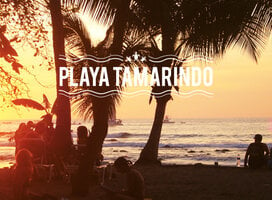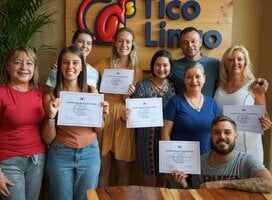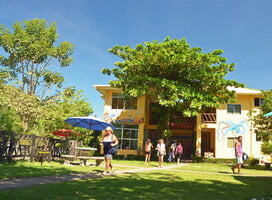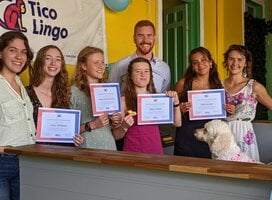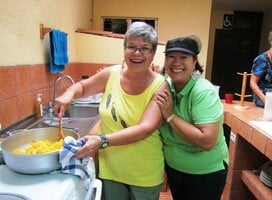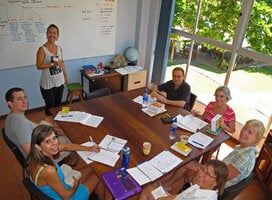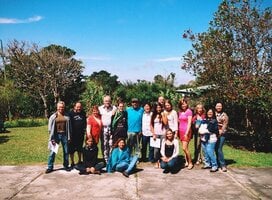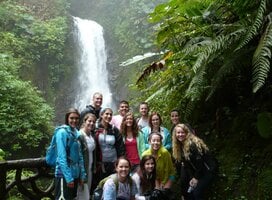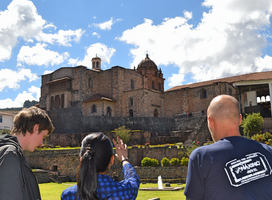Spanish Language Schools in Costa Rica
This tiny little country located in the heart of Central America is often considered to have a fairly neutral dialect of Spanish that is easy for non-native learners to pick up and understand. There’s no doubt that accents and jargon vary amongst the 21 countries where Spanish is the native language, so this is a good place to start.
Also a major bonus, Costa Rica is one of the most politically stable and literate nations in Central America and may be a more economically friendly solution if you’re flying from the US or are comparing cost-of-living to some other nations, such as Spain.
Let’s not forget the inherent friendliness and beauty of this outdoor paradise. As if the tropical climate and beaches weren’t enough, the mountains and rainforests sprawling across Costa Rica provide the adventurer’s dreamland and offer up activities including hiking, whitewater rafting, zip lining, skydiving, and horseback riding. Oh, and there’s the awesome cuisine to consider, such as gallo pinto and the world-famous Costa Rican coffee!
Read the guide on this page written by Go Overseas experts, just for you. Then choose a Spanish language program in Costa Rica from the list below. You'll be well on your way to becoming a fluent Spanish speaker!
Ok, let’s be frank. Before you can decide if learning Spanish in Costa Rica is right for you, you need to be honest with yourself and consider a couple of very important factors. First, what is your current level of Spanish, and how good do you want it to be? This will greatly affect what types of programs you may be eligible, and which will suit you best. It’s also very important to be cognizant of any restrictions you may have, say from your home institution or budget. These can both affect the length of your visit and the nature of your program. The decision on whether or not to stay with a host family may also ultimately impact your decision and/or how quickly you will pick up the language.
Program Types
- University Courses: This is a great option if you plan to spend an extended time, as in a semester or longer, in Costa Rica. It also provides the option to take other, non-Spanish university courses that you may need for your university degree. Depending on the university and/or course, these may or may not be conducted completely in Spanish. Some may even have Spanish language proficiency requirements. These types of programs may require a more difficult enrollment process because you may have to apply to the local university, whether through your home institution on your own. Some of these courses have more than the small group set-up that some language schools may offer, but the university environment does have the potential to introduce you to locals that are your age.
- Group classes: A popular way to learn Spanish in Costa Rica is in private language schools that teach small group courses, often in groups of only 2-4 students. Sometimes, these courses are full immersion and are taught completely in Spanish, even for beginners as a way to get you to learn as much as possible. A definite pro for this type of program is the individualized attention that is available and the ability for most of these programs to accept students at any stage in their Spanish-learning journey or of almost any age. They are also often to cater to your schedule, whether it be the length of time you wish to attend, or what time of day you are available for lessons. This is a great option if you only have, say, two weeks, but could also be great if you want to stay three months. Many US universities even partner with some of these language schools to award students college credit for their attendance.
- Private Tutorting: Private tutoring is often a very flexible option that can also work for any age group. These arrangements can be set up by private language companies, but can also be done independently through advertisements and networking sites. Therefore, this has the potential to be more cost-effective if the tutor is willing to negotiate prices. One thing to consider is how often you will have lessons. If your tutoring sessions are only once a week, this may require a lot more independent learning to get to the same level as if you spent the same amount of time in a full-immersion language school everyday. However, if you’re highly self-motivated, just need a refresher course, or are only looking to dabble in the language, this has the potential to be a great option. It’s also great if you’re looking to do a language-exchange with your tutor to help teach them English.
- Homestay Programs: Homestays are often a component of one of the previously mentioned programs. A lot of schools help to set up students with host families as a way to give them extra Spanish practice, help them join into the community, and have an extra-special experience.
Cultural Immersion/Extracurricular Activities
There’s no doubt that one of the best ways to learn a language is to fully immerse yourself in it. The host family option that many programs either offer or require is an excellent way to improve your Spanish the quickest way possible. It is also a wonderful to truly immerse yourself in the Tico culture and get a unique and authentic experience, not to mention the best beans and rice! Anything that engages you with the local community, such as volunteer work, is a highly recommended way to, not only aid your Spanish, but also enrich your experience. Also, as ecotourism and biodiversity are a major part of what makes Costa Rica tick, traveling around and exploring the many national parks and various forms of environmental and agricultural offerings are especially invaluable experiences.
Highlights
- Check out the crowd: There are about 4.8 million people who live in Costa Rica, almost all of whom speak Spanish, so you won’t have any problem finding people to talk to.
- Did you know..? Costa Rica is only a mere .03% of the world’s population but makes up about 6% of the world’s biodiversity!
- School’s out, let’s have some fun: Nestled between the Pacific and Atlantic Oceans, you’ll never be far from a beach in Costa Rica.
- Wow others with an Idiom! You can’t go far in Costa Rica until you learn the popular phrase pura vida, which means “pure life” or basically that everything is just peachy and you should enjoy life.
Qualifications
Personal qualifications, again, are largely dependent on the specific program and any other requirements you may have, such as guidelines from your university to complete credits for a language degree. The best plan is to check with both your Costa Rican program provider and home institution well in advance.
As far as visa requirements, students from the US usually only require their passport as a visa, which is good for 90 days and can be renewed by exiting and reentering the country. For more information, check out the Costa Rican Embassy website. While participants in language programs are often in their college years, there are countless organizations that have programs that cater to people from little pipsqueaks to adults well into their retirement.
There are also programs that are geared for people without a lick of Spanish language experience to those with extremely high proficiency levels. What all of this means is, don’t fret—there’s a really good chance that there’s a program that can work out great for you regardless of your age and experience.
City Info
San Jose
As the capital city located in the heart of this small nation, San Jose is the center of a lot of the happenings in Costa Rica. It’s got several great museums and culture points, like the Teatro Nacional, to keep you both entertained and educated.
This is also the major business and political point in the country with the biggest chunk of the population, so there are plenty of different schools to choose from here. The central location of this capital city within the country also makes it an ideal location if you’re looking to do a lot traveling, as everything is very accessible from this point.
Heredia
As a smaller province located northwest of San Jose, Heredia is also a popular destination in Costa Rica. This region is currently modernizing while still preserving a lot of its traditional charm and architecture. There are also plenty of schools in this region to choose from, ranging from private language schools to popular universities for students studying abroad. It is a bit more rural than nearby San Jose, but still within easy access of the city.
The good news is that Costa Rica is not an exceptionally expensive country, but for those on a budget, there are some ways to help make ends meet. First, the more tourist hotspots, such as beach towns, are usually more expensive than small towns, such as Santa Ana. If you’re doing this for college credit, look into some of the programs that offer much lower tuition rates than you may be paying at your home institution.
Tourist season in Costa Rica is over the US winter months, so this may also create inflated costs during these times, especially for things like airfare and lodging. If you’re looking to make a bit of extra money while you’re there, consider giving private or group English lessons to locals. This may also be a way to exchange services and help lower costs for somebody who may be giving you private Spanish lessons.
Scholarships
Many programs or home universities offer private scholarships for studying Spanish in Costa Rica. There are also outside organizations that offer scholarships for these types of language-learning programs. For example, Modern Language Studies Abroad offers scholarships specifically for current Spanish teachers and Spanish majors or minors still in college wanting to study in Costa Rica. AFS Intercultural Programs also offers scholarships for students looking to study in Costa Rica for at least a semester.

